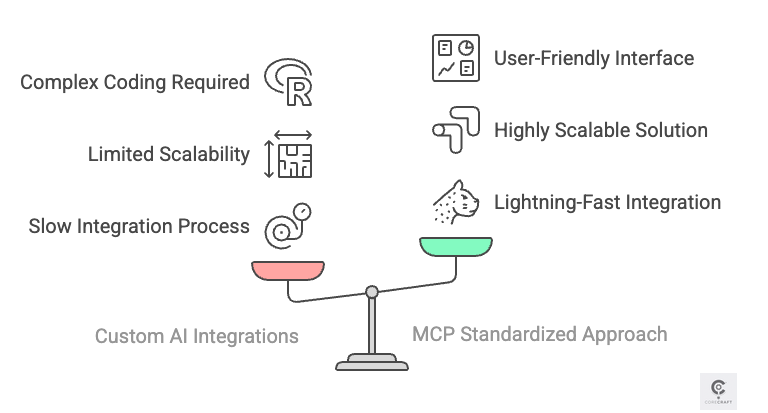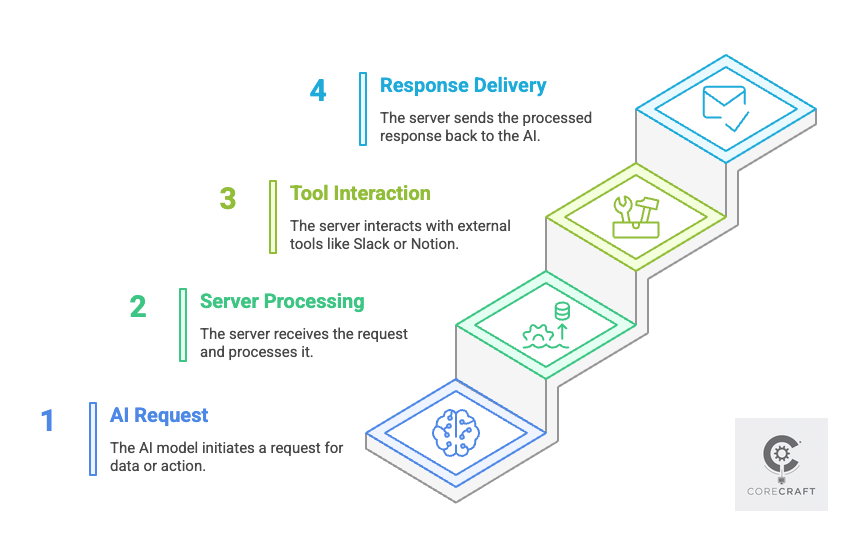Why MCP Is AI’s Universal Plug You Can’t Ignore
#15 How Model Context Protocol Is Rewiring AI to Supercharge Tech Game
Picture this: your AI assistant books a flight, syncs your calendar, and pings your team on Slack—all in seconds, no coding required. Sounds like magic? It’s the Model Context Protocol (MCP), the hottest trend in AI. Whether you’re a coder wrestling with APIs or a business owner craving automation, MCP is your ticket to making AI do the heavy lifting. Let’s dive into why this protocol is blowing up and how it’s about to change your tech life.
1. Introduction
The Model Context Protocol (MCP), launched by Anthropic in November 2024, is a game-changing standard that lets AI models—like Claude or ChatGPT—seamlessly connect to apps, data, and tools.
Think of it as the USB-C of AI: one protocol to rule them all, from GitHub to Google Drive.
With tech giants like OpenAI and Microsoft jumping on board, MCP is trending big-time on platforms like X, and for good reason. This article unpacks what MCP is, why it’s a must-know, and how it’s empowering developers, businesses, and everyday users to unlock AI’s full potential.
2. What is MCP?
MCP is an open-source protocol that standardizes how AI models interact with external systems, like databases, apps, or your email.
Instead of writing custom code for every connection (a developer’s worst nightmare), MCP acts like a universal adapter, letting AI plug into anything with ease.
Examples:
Coding Magic: In your IDE (like Cursor), an AI uses MCP to query a database, run tests, and push code to GitHub without you switching tabs.
Business Boost: Your AI assistant grabs live sales stats, updates your CRM, and emails a report—all from one simple command.
Why it matters:
MCP transforms AI from a clever chatbot into a do-it-all partner, slashing time and tech headaches.
3. Why MCP is Essential
MCP solves the chaos of AI integrations. Without it, linking AI to tools means custom code for every app—slow, buggy, and tough to scale. MCP’s standardized approach fixes this, making AI more practical and powerful.
A 2024 Gartner report notes 70% of AI projects fail due to data silos and integration issues—MCP is the antidote.
Examples:
Developer Win: Forget writing separate scripts for Slack, GitHub, and PostgreSQL. MCP servers connect them in minutes.
Business Hack: A small business owner says, “Summarize today’s sales and notify my team.” MCP lets the AI pull data from Shopify, crunch numbers, and post to Slack instantly.
Benefits:
Lightning Speed: Build integrations 10x faster with reusable MCP servers.
Scales Like a Dream: One protocol works across endless tools and AI models.
No PhD Needed: Non-coders can use MCP-powered apps like Claude Desktop for complex tasks.
4. How Does MCP Work?
MCP uses a simple client-server setup to connect AI to the world. Here’s the breakdown:
MCP Host: The AI model (e.g., Claude) that needs to act or fetch data.
MCP Client: An app or IDE sending requests to servers.
MCP Server: A tiny program linking tools (e.g., Slack, Notion) to the AI.
Flow: The AI sends a request, the server does the work, and the answer zips back.
Examples:
Data Dive: Ask, “How many users signed up today?” An MCP server queries your PostgreSQL database and delivers the number.
Creative Spark: Tell Claude, “Make a retro synth track.” An MCP server for Ableton sets the vibe, adds MIDI, and applies effects.
Why it works:
MCP’s universal language lets AI “speak” to any tool flawlessly, streamlining tasks and cutting errors.
5. Types of MCP Use Cases
MCP’s versatility is its secret weapon. Here’s how it shines across different scenarios:
Developer Workflows
Explanation: MCP supercharges coding by linking AI to dev tools like Git or Docker.
Example: In Cursor, AI uses an MCP Browsertools server to debug code by checking live console logs.Business Automation
Explanation: MCP connects AI to business apps for effortless task automation.
Example: AI pulls sales from Shopify , updates a Google Sheet, and Slacks the team—all in one go.Creative Applications
Explanation: MCP lets AI control creative software for music, design, or video.
Example: Claude uses an MCP server to tweak Ableton, crafting a song based on your prompt.
These use cases show MCP’s power to solve real-world challenges, from code to creativity.
6. The Big Picture: MCP in the Future of AI
As AI becomes the backbone of industries, MCP’s ability to connect models to any system positions it as the glue holding the AI era together. MCP’s open-source nature and adoption by giants like OpenAI and Google suggest it could become the standard for AI interoperability, much like HTTP for the internet.
By 2030, analysts predict 80% of enterprise AI will rely on protocols like MCP to break data silos and drive innovation.
Examples:
Smart Cities: MCP could let AI coordinate traffic lights, public transit, and energy grids by connecting to municipal systems, reducing congestion and emissions.
Personal AI Agents: Imagine an AI that uses MCP to link your fitness tracker, grocery app, and kitchen appliances to plan meals, track nutrition, and order ingredients—all tailored to your health goals.
MCP’s future is about making AI invisible yet indispensable, like electricity. It’s not just for coders or businesses—it’s for everyone dreaming of a smarter, more connected world.
Conclusion
The Model Context Protocol (MCP) isn’t just a tech buzzword—it’s your ticket to making AI your ultimate wingman. By standardizing connections between AI and tools, MCP saves coders from integration hell, powers businesses with slick automation, and lets creatives jam with AI. MCP is set to redefine how we work with tech.
Want in? Check out the MCP, test a server, or join the buzz on X to swap ideas.
Thank You for Reading!
If you found this article helpful, hit the ❤️ button and consider subscribing for more content every week.
Have questions or suggestions? Leave a comment—I’d love to hear your thoughts!
Stay connected:
Follow me on LinkedIn and X to stay updated with my latest posts.




